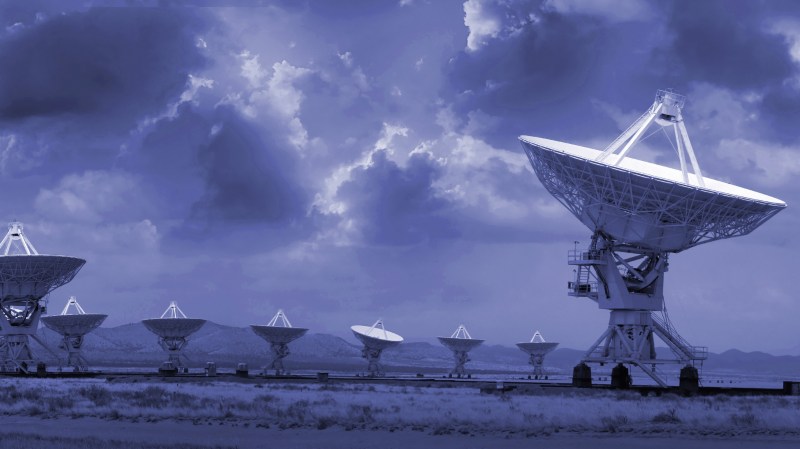Join us on Wednesday, February 12 at noon Pacific for the DIY Radio Telescopes Hack Chat with James Aguirre!
For most of history, astronomers were privy to the goings-on in the universe only in a very narrow slice of the electromagnetic spectrum. We had no idea that a vibrant and wondrous picture was being painted up and down the wavelengths, a portrait in radio waves of everything from nearly the moment of creation to the movement of galaxies. And all it took to listen in was an antenna and a radio receiver.
Over the years, radio telescopes have gotten more and more sophisticated and sensitive, and consequently bigger and bigger. We’re even to the point where one radio telescope often won’t cut it, and astronomers build arrays of telescopes spread over miles and miles, some with antennas that move around on rails. In the search for signals, radio astronomy has become the very definition of “Big Science.”
But radio astronomy doesn’t have to be big to be useful. James Aguirre, an astronomer at the University of Pennsylvania, spends his days (and nights) studying the radio universe with those big instruments. But he’s also passionate about down-scaling things and teaching everyone that small radio telescopes can be built on the cheap. His Mini Radio Telescope project uses a cast-off satellite TV dish and a couple of hundred bucks worth of readily available gear to scan the skies for all sorts of interesting phenomena.
Dr. Aguirre will join us on the Hack Chat to discuss all things radio astronomy, and how you can get in on the radio action on the cheap. Chances are good your junk pile — or your neighbor’s roof — has everything you need, and you might be surprised how approachable and engaging DIY radio astronomy can be.
 Our Hack Chats are live community events in the Hackaday.io Hack Chat group messaging. This week we’ll be sitting down on Wednesday, February 12 at 12:00 PM Pacific time. If time zones have got you down, we have a handy time zone converter.
Our Hack Chats are live community events in the Hackaday.io Hack Chat group messaging. This week we’ll be sitting down on Wednesday, February 12 at 12:00 PM Pacific time. If time zones have got you down, we have a handy time zone converter.
Click that speech bubble to the right, and you’ll be taken directly to the Hack Chat group on Hackaday.io. You don’t have to wait until Wednesday; join whenever you want and you can see what the community is talking about.

















When I was at uni we were really close to building one of the “Simple” interferometers based on the one at Narrabri:
https://www.atnf.csiro.au/news/newsletter/oct02/simple.htm
We didn’t have the space unfortunately, but it looked like a great project which wasn’t expensive, and one of the few feasible interferometry projects for an amateur. It appears the fringes.org site which had great instructions has been updated and I can’t find much relevant information on it anymore :(
http://fringes.org/
That’s interesting I was about to ask the same question. So to help you out in turn, nothing is safe from the waybeck machine, e.g. look at https://web.archive.org/web/20170609222322/http://fringes.org/ there seems to be a lot more useful stuff archived.
Please let us know which dates are optimal to look at the site.
I was thinking about direct conversion but at much higher carrier frequency, e.g. 700MHz up to 2GHz is my area of expertise from working on mobile phones. However, don’t the LNA’s have their own mixers? I’ll have to look into how to phase-lock the whole thing together. The ideal would be to have 3 dishes spatially separated to get a much bigger effective aperture (the size of my garden…) and therefore much greater image resolution.
Now to noise… working on low-cost GSM basestations I have had a lot of experience putting RPi’s in with RF kit – I would look at adding some isolation between the logic boards and RF front end in the case. RPi’s kick out all sorts of spurious, but luckily it’s fairly peaky, so if you have a narrowband receiver you can avoid the peaks.
Low noise block converters have mixer circuitry. How relevant used or surplus units are to radio astronomy, and how easily they can be modified I don’t know.
I guess I’ ll have to tune in tomorrow.
I’ve been working on something similar for the last 4 years or so.
I recently got around to writing a few blog posts about it:
https://josepheoff.github.io/posts/rfcamera
It can make terrestrial photos, but can also make images of the heavens.
I have a long way to go on the software I’ve been writing for it – I have high aspirations.
“Why I get mostly the 100Hz harmonic is a puzzle – probably has to do with the electronics driving it, but I’m not interested in that enough to find out what is really going on. Maybe one of ya’ll would like to take a stab at it?”
Well that’s easy. The fluorescent light arc strikes with every pulse of mains electricity. With A.C. there are two pulses per cycle, + and -. So you get a frequency doubling effect. 50Hz mains gives you 100Hz flicker.
Doh! Thanks. I should have realized that.
Very cool project, Joe. I noticed that the RSS feeds on your site, https://josepheoff.github.io/feed.xml , doesn’t actually work. It’d be cool if it did so I could add your blog to my RSS feeds.
Thanks for kind words – and the reminder. I’ve been meaning to look into the broke rss feed. It’s fixed now.